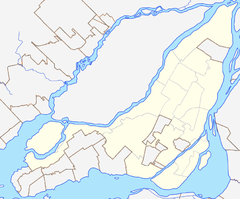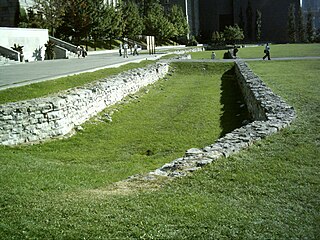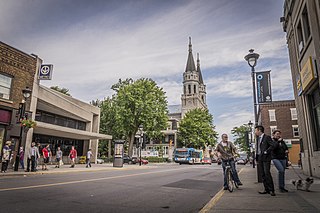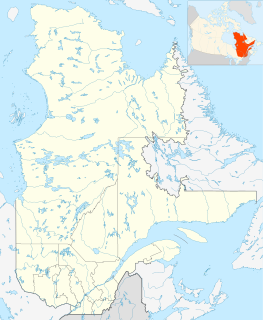Coordinates: 45°29′51″N73°33′23″W / 45.497528°N 73.556308°W

A geographic coordinate system is a coordinate system that enables every location on Earth to be specified by a set of numbers, letters or symbols. The coordinates are often chosen such that one of the numbers represents a vertical position and two or three of the numbers represent a horizontal position; alternatively, a geographic position may be expressed in a combined three-dimensional Cartesian vector. A common choice of coordinates is latitude, longitude and elevation. To specify a location on a plane requires a map projection.
| Poste Adélard-Godbout | |
|---|---|
Poste Adélard-Godbout in 2012 | |
| General information | |
| Type | Electrical infrastructure |
| Architectural style | Neo Classical |
| Address | 733 Wellington Street |
| Town or city | Montreal, Quebec |
| Country | Canada |
| Coordinates | 45°29′51″N73°33′23″W / 45.497528°N 73.556308°W |
| Completed | 1904 |
| Owner | Hydro-Québec |
The Poste Adélard-Godbout is a 120 kV electrical substation in Old Montreal. Canada's oldest substation, it has been in continuous operation since 1901. It contains two stories above ground and one below ground. It has a facade in clay brick with grey stone ornaments.

A substation is a part of an electrical generation, transmission, and distribution system. Substations transform voltage from high to low, or the reverse, or perform any of several other important functions. Between the generating station and consumer, electric power may flow through several substations at different voltage levels. A substation may include transformers to change voltage levels between high transmission voltages and lower distribution voltages, or at the interconnection of two different transmission voltages.

Old Montreal is a historic neighbourhood within the municipality of Montreal in the province of Quebec, Canada. Founded by French settlers in 1642 as Fort Ville-Marie, Old Montreal is home to many structures dating back to the era of New France. The 17th century settlement lends its name to the borough in which the neighbourhood lies, Ville-Marie. Home to the Old Port of Montreal, the neighbourhood is bordered on the west by McGill Street, on the north by Ruelle des Fortifications, on the east by rue Saint-André, and on the south by the Saint Lawrence River. Following recent amendments, the neighbourhood has expanded to include the Rue des Soeurs Grises in the west, Saint Antoine Street in the north, and Saint Hubert Street in the east. In 1964, much of Old Montreal was declared a historic district by the Ministère des Affaires culturelles du Québec.
Designed by Maurice Perrault, it was built between 1901 and 1904. Initially it received 12 kV current from the now defunct Lachine hydroelectric generating station. Later it received 25 kV from a generating station in Chambly (demolished in 1964). [1]

Maurice Perrault was a Canadian architect, civil engineer, and politician.

Chambly is an off-island suburb in southwestern Quebec, Canada, about 25 km (16 mi) to the south east of Montreal.
It was built by the Montreal Light, Heat & Power Company (MLHPC) and became the property of Hydro-Québec in 1944 during the nationalization of Quebec's electrical infrastructure. [2]

The Montreal Light, Heat and Power Company (MLH&P) was a utility company operating the electric and gas distribution monopoly in the area of Montreal, Quebec, Canada, until its nationalization by the government of Quebec in 1944, under a law creating the Quebec Hydroelectric Commission, also known as Hydro-Québec.

Hydro-Québec is a public utility that manages the generation, transmission and distribution of electricity in Quebec.
Nationalization is the process of transforming private assets into public assets by bringing them under the public ownership of a national government or state. Nationalization usually refers to private assets or assets owned by lower levels of government, such as municipalities, being transferred to the state. The opposites of nationalization are privatization and demutualization. When previously nationalized assets are privatized and subsequently returned to public ownership at a later stage, they are said to have undergone renationalization. Industries that are usually subject to nationalization include transport, communications, energy, banking, and natural resources.
Originally Poste Central-1, in 2007 it was renamed after former Premier of Quebec Adélard Godbout on the 50th anniversary of his death.

The Premier of Quebec (French: Premier ministre du Québec or Première ministre du Québec is the head of government of the Canadian province of Quebec. The current Premier of Quebec is François Legault of the Coalition Avenir Québec, sworn in on October 18, 2018 following the 2018 election.

Joseph-Adélard Godbout was a Canadian agronomist and politician. He served as the 15th Premier of Quebec briefly in 1936, and again from 1939 to 1944. He was also leader of the Parti Libéral du Québec (PLQ).












